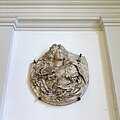Gabriel Grupello


Gabriel Grupello , even Gabriel Grupello (* 23. May 1644 in Geraardsbergen , † 20th June 1730 at Castle Erenstein in Kerkrade ), was a Flemish sculptor of the Baroque .
Life
Gabriel Grupello was born in Geraardsbergen in East Flanders as the son of Italian cavalry captain Bernardo Rupelli and his Flemish wife Cornelia Delinck. His father, who died early, belonged to the upper non-aristocratic class of society. Grupello was later addressed as Chevalier de Grupello , but no aristocratic descent can be proven.
At the age of fourteen he began a five-year apprenticeship as a sculptor with Artus Quellinus in Antwerp , whether the younger or the older is unknown, but probably with Artus Quellinus the older . Then Grupello went to the Hague sculptor Johann Lasson and finally to study for two years in Paris and Versailles, where he learned the bronze casting technique during a two-year stay .
In 1671 he applied for citizenship in Brussels and opened his own workshop. He worked for various rulers, including the Spanish King Charles II , Wilhelm II of Orange and the Brandenburg Elector Friedrich III.
In 1695 Grupello was appointed by the Palatinate Elector Johann Wilhelm , known as Jan Wellem, to the court in Düsseldorf as court statuary . Grupello created numerous sculptures of the ruling couple from marble and bronze and was responsible for the supervision of craftsmen who worked on the electoral palaces. In 1708 Johann Wilhelm II. Duke of Jülich and Berg donated the house at Marktplatz 3 , built by Matteo Alberti in 1706 . This was where, among other things, the workshops and the casting house , which later became the Grupello theater , the artist, in which the equestrian statue was made.
With the death of the elector in 1716, the sculptor's activity at court ended. Johann Wilhelm's successor, Elector Carl Philipp , implemented austerity measures and released officials and artists with grace. Emperor Charles VI. appointed him in 1719 as an Imperial Statuarius with a salary of grace . Grupello now mainly turned to sacred art. In 1725 Grupello moved with his wife Maria Anna, née Dautzenberg (1670 / 1676–1735), to their daughter, who was married to an imperial fief director ( Amtsschultheiß ), at Schloss Ehrenstein . There he died in 1730 at the age of 86.
Honors
Streets in Düsseldorf, Neuss and Mannheim were named after Grupello.
plant
The marble wall fountain, which he created for the ballroom of the sea fish traders' guild, is considered to be the main work of Grupello's Brussels time. From his creative period in Düsseldorf, two monumental works of art made of cast bronze stand out, the equestrian statue of Elector Johann Wilhelm (Jan Wellem) on the Düsseldorf market square and the Grupello pyramid , which today stands on the Paradeplatz in Mannheim . He also made statues, which can be seen in the palace gardens of Schwetzingen Palace . Many of the sacred works of art from his late work are considered lost or were destroyed in the fire at Düsseldorf Palace . A splendid bronze sarcophagus of the Elector Jan Wellem was preserved in the mausoleum of the Düsseldorf court church St. Andreas .
Gabriel Grupello, self-portrait around 1700, Museum Kunstpalast Düsseldorf
Emperor Joseph I , shortly after 1705, Düsseldorf Art Academy
Empress Wilhelmine Amalie , shortly after 1705, Düsseldorf Art Academy
Our Lady, linden wood around 1725, Museum Schnütgen Cologne
literature
- Richard Klapheck : Grupello, Gabriel . In: Ulrich Thieme , Fred. C. Willis (Ed.): General lexicon of visual artists from antiquity to the present . Founded by Ulrich Thieme and Felix Becker . tape 15 : Gresse – Hanselmann . EA Seemann, Leipzig 1922, p. 148 ( Textarchiv - Internet Archive ).
- Udo Kultermann : Gabriel Grupello . Berlin 1968.
- Kunstmuseum Düsseldorf (ed.): Guide through the collections volume 1. Düsseldorf 1992.
- Heinrich J. Schmidt: Grupello, Gabriel. In: New German Biography (NDB). Volume 7, Duncker & Humblot, Berlin 1966, ISBN 3-428-00188-5 , p. 234 ( digitized version ).
Individual evidence
- ↑ Udo Kultermann: Gabriel Grupello . P. 26.
- ↑ Rudi Dorsch: Grupello pyramid in new splendor . Mannheim 1993.
Web links
- Works by and about Gabriel Grupello in the German Digital Library
- Important works
- Family: Gabriel de Grupello , on Familienbuch-euregio.eu
| personal data | |
|---|---|
| SURNAME | Grupello, Gabriel |
| ALTERNATIVE NAMES | Grupello, Gabriel de |
| BRIEF DESCRIPTION | Flemish sculptor |
| DATE OF BIRTH | May 23, 1644 |
| PLACE OF BIRTH | Geraardsbergen |
| DATE OF DEATH | June 20, 1730 |
| Place of death | Erenstein Castle near Kerkrade |




